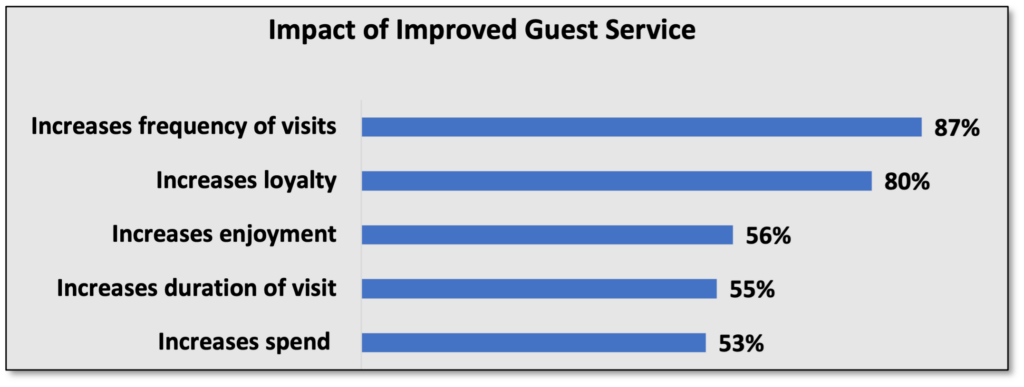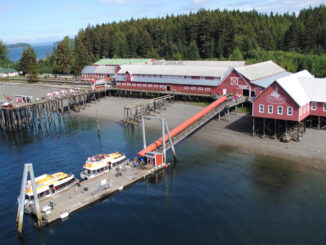Many people believe that guest service is a differentiator in a competitive market, but they don’t know how to build a model to justify the expense of investing in guest service improvements. If this describes you, then keep reading to learn about some tools to reliably measure how guest service impacts profitability.
First, here are some of the benefits of good guest service:
Good guest service increases revenue and profitability.
Studies have shown that improving the customer experience can increase sales revenue by 2-7% and profitability by 1-2%.
Customer retention is cheaper than customer acquisition.
Research indicates that the customer service acquisition cost (CAC)—how much it costs to acquire a new customer—is higher for a company that doesn’t invest a percentage of its budget in guest service. Ultimately, investing in guest service can decrease your churn rate. Decreasing churn rate reduces the amount you must spend on acquiring new customers and decreases the overall CAC.
Customers will pay more to companies with better guest service.
Over 80% of customers in a recent survey reported that receiving value during a service experience makes them more likely to repurchase even when given a chance to switch to a competitor.
Guest service grows customer lifetime value.
Customer lifetime value (CLV) represents the total revenue you can expect from a single customer account. Growing this value means your customers shop more frequently or spend more money at your business.
Guest service can give you a competitive advantage.
By offering best-in-class guest service, you are attaching value to your company’s brand, strengthening your reputation in the market place and showing by example that you care about the people who visit your casino.
Now, let’s look at tools to measure and quantify the impact of guest service at your property.
Direct Guest Service Measurement: Player Guest Service Survey
CSAT (Customer Satisfaction) is a commonly used key performance indicator to track how satisfied customers are with your organization’s products and/or services. At Raving, we use the CSAT survey format to focus on specific guest service components.
As an experience metric, CSAT uses multiple questions to focus on specific parts of the customer experience. For example, it might ask how your customers rank overall guest service at your property, as well as guest service levels in specific areas such as dining venues or players club. The survey respondent is then given a scale of 1 to 5 to record their answer.
Only responses of 4 (satisfied) and 5 (very satisfied) are included in the calculation, as it has been shown that using the two highest values on feedback surveys is the most accurate predictor.
The guest service survey also asks how your players compare your guest service with what they experience at competitor properties. After all, if you’re considering amping up your guest service program, you can be sure that your competitors are also working on improving their guest service.
Indirect Guest Service Measurement: Net Promoter Score (NPS)
NPS is the number one system that companies worldwide use to monitor their customer experience (CX), and Raving’s direct research consistently shows that guest service plays a major role in CX.
Originally, NPS was discovered by researchers investigating survey questions that could be asked of customers to predict revenue growth. Out of 19 questions, one proved most accurate: On a scale from 0 to 10, how likely are you to recommend the product/service/brand to a colleague or friend?
This NPS question measures overall customer experience, loyalty and satisfaction. It identifies three categories of customers, in terms of their possible impact on growth:
- Detractors. They are most likely to churn, spread negative word-of-mouth, and negatively impact your revenue.
- Promoters. They are enthusiastic customers who will recommend your product, drive referrals, and provide opportunities for upselling.
- Not quite enthusiastic, but not yet detractors, passives are both potential for growth and at risk of churn.
To calculate NPS, subtract your percentage of detractors from your percentage of promoters and you have a number out of 100. The average casino NPS score is 30.
Does NPS Correlate with Revenue Growth?
The research behind NPS clearly shows a correlation between improving your NPS score and revenue growth. One study found that a 10+ increase in NPS score correlates with a 3.2% increase in revenue.
Summary
The benefits of providing outstanding guest service to your players are well documented. You know intuitively that this is critical for your business success. Quantifying the benefits of guest service, however, may have been a mystery for you. The tools outlined in this article are just some of the ways to get reliable data to justify to your GM and/or Tribal Council the importance of investing in guest service at your property.
Key Takeaways From This Article:
- Understanding how good guest service can impact revenue and profitability.
- Knowing what tools are available to measure the effectiveness of your guest service, and how to use them.
- Net Promoter Score—why you should be using this important metric.
- Learn how financial linkage ties all the metrics into a clear picture of how guest service impacts your operation.
Research is one of the most underutilized tools available to us in our industry. When in fact, gathering this data should be the first step before we make changes to our players club, add a new restaurant, or purchase a new game or technology. Reach out to Raving today to chat about the many aspects of research that can help your organization today.





